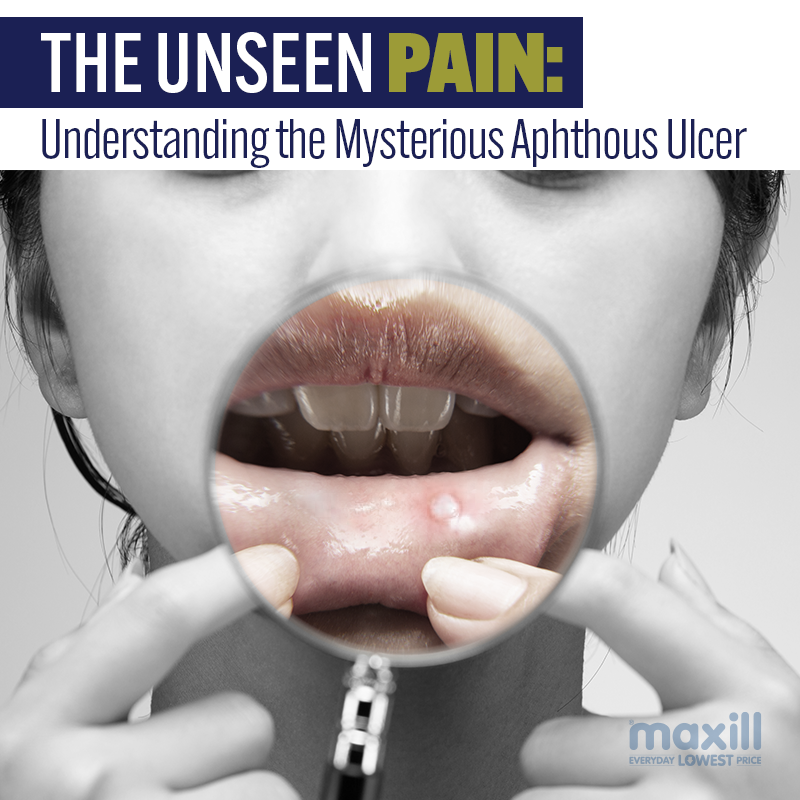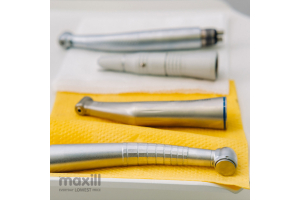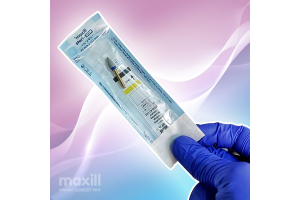The Unseen Pain: Understanding the Mysterious Aphthous Ulcer

Introduction
Aphthous ulcers, also known as canker sores, are a type of mouth ulcer many experience at some point in their lives. While they may seem harmless, these ulcers can cause significant pain and discomfort, making chewing, speech, and oral home care difficult. Despite their common occurrence, the exact cause of aphthous ulcers remains a mystery, and there is no known cure. This blog will delve into the unseen pain of aphthous ulcers, exploring their symptoms, potential causes, and available treatments. Understanding this condition can help provide much-needed relief and support for our patients.
What is an aphthous ulcer?
Oral aphthosis is a painful and recurring inflammatory process of the oral mucosa producing ulcers affecting 20-25% of the population worldwide. These ulcers typically appear as small, round, or oval-shaped sores with a white or yellowish center encircled by a red border. Most commonly occur on the non-keratinized buccal and labial mucosa, soft palate, floor of the mouth, ventral or lateral surface of the tongue, tonsillar fauces, and marginal gingiva.1,2.
Despite their relatively small size, aphthous ulcers can cause significant discomfort and pain due to their location within the mouth. Eating, drinking, and speaking can become difficult and painful with these ulcers, significantly impacting a person's quality of life.
It is important to note that aphthous ulcers differ from cold sores caused by the herpes simplex virus. Unlike cold sores, aphthous ulcers are not contagious and cannot be spread from person to person.
Types of aphthous Ulcers 1
Aphthous ulcers can vary in appearance, size, and frequency of occurrence. The severity of symptoms may also differ based on the type of aphthous ulcer. Here are three main types of apthous ulcers:
- Minor aphthous ulcers are the most common type, accounting for about 80% of cases. They are small, round, or oval-shaped sores with a white or yellowish center and a red border. Minor apthous ulcers are usually less than 5mm in diameter and heal within 1-2 weeks without scarring.
- Major aphthous ulcers: Major aphthous ulcers are less common than minor ulcers but are larger and more painful. They can be more than 1cm in diameter and may take several weeks or months to heal. Major aphthous ulcers can leave scars after healing, often resulting in more severe discomfort and difficulty eating and speaking.
- Herpetiform aphthous ulcers: Rare Herpetiform aphthous ulcers are named because they resemble the sores caused by the herpes simplex virus and occur in only 1-10% of patients. However, unlike cold sores, herpetiform ulcers are not caused by a viral infection. They are typically small in size but occur in clusters, with multiple ulcers appearing at the same time. These ulcers can be painful and take 1-2 weeks to heal.
It's important to note that individuals may experience a combination of these types, and the severity and frequency of ulcers can vary from person to person. Some individuals may only have occasional ulcers, while others may have recurrent episodes with multiple ulcers appearing simultaneously.
In some cases, additional tests or biopsies may be performed to rule out underlying conditions.
Associated systemic symptoms: If the ulcers are accompanied by other concerning symptoms such as fever, fatigue, unexplained weight loss, or swollen lymph nodes, it is vital to seek medical attention. These symptoms may suggest an underlying systemic condition that requires further evaluation and management.
Causes and potential triggers
- Trauma or injury: Ulcers may develop as a response to the trauma, such as accidental cheek bites, toothbrush abrasions, or dental work, causing localized inflammation and discomfort.
- Hormonal changes: Hormonal fluctuations have been associated with developing aphthous ulcers. Many women report experiencing ulcers during menstruation or hormonal changes related to pregnancy.
- Vitamin or mineral deficiencies: Deficiencies in iron, vitamin B12, folic acid, or zinc can compromise the immune system and the overall health of the oral tissues, making them more susceptible to ulcer formation.
- Stress and emotional factors: Emotional stress and anxiety can trigger apthous ulcers. The exact mechanisms are still not completely understood. Still, it is believed that stress can weaken the immune system and disrupt the normal healing processes in the oral cavity, leading to ulcer development.
- Certain foods and beverages: Spicy and acidic foods, such as citrus fruits, tomatoes, chocolate, and coffee, have been reported to exacerbate aphthous ulcers in some individuals.
- Genetic predisposition: Evidence suggests that specific individuals may have a genetic predisposition to developing aphthous ulcers.
Treating apthous ulcers 2,3
- Over-the-counter topical treatments: Utilizing topical medications containing benzocaine or lidocaine, such as mouthwashes, gels, or sprays, can relieve temporary pain and help protect the ulcers from further irritation.
- Prescription medications: Corticosteroids such as dexamethasone reduce inflammation and promote healing, or oral rinses with antimicrobial properties to prevent secondary infections.
- Oral hygiene and lifestyle modifications: Good oral hygiene practices, such as regular brushing and flossing, can help prevent further irritation and promote healing. Also, avoid trigger foods or substances that may exacerbate the ulcers, such as spicy or acidic foods. Stress management techniques and maintaining a healthy lifestyle may also reduce the frequency of ulcer episodes.
- Severe cases and underlying conditions: In rare cases, when the ulcers are extremely painful, large, or persistent, more aggressive treatment approaches may be necessary. These can include oral corticosteroid tablets, immune-modulating medications, or Debacterol or silver nitrate cauterization. If the apthous ulcers are associated with an underlying medical condition, treating the underlying disease may also help manage the ulcers.
Preventive measures 2
Individuals can take preventive measures to reduce the likelihood of developing these sores and better manage the impact of apthous ulcers on their daily lives. Here are some preventative measures to consider:
- Good oral hygiene: Proper oral hygiene is essential in preventing the formation of aphthous ulcers.
- Avoid trigger foods: Certain foods can exacerbate or trigger the onset of aphthous ulcers. Spicy, acidic, or rough-textured foods such as chips, pretzels, and citrus fruits have been known to irritate.
- Reduce stress: Stress has been linked to aphthous ulcers.
- Avoid trauma to the mouth: Accidental bites, burns from hot beverages, or mouth injuries can trigger aphthous ulcers.
- Maintain a balanced diet: A well-balanced diet that provides all the essential vitamins and minerals can help boost your immune system and promote oral health.
- Manage underlying health conditions: Some medical conditions, such as inflammatory bowel disease, celiac disease, and HIV/AIDS, have been associated with an increased risk.
- Avoid tobacco and alcohol: Tobacco use and excessive alcohol consumption can irritate the mouth and increase the risk.
Conclusion: Taking care of your oral health
Maintaining good oral health is essential for overall well-being, including caring for conditions like aphthous ulcers. While aphthous ulcers can be mysterious and challenging to deal with, there are steps you or your patients can take to promote oral health and reduce the frequency or severity of these ulcers. ®maxill is deeply invested in your ability to help your patients maintain good oral health, supplying you with many different kits and oral care products you can offer your patients after their appointment. For the lowest everyday pricing on dental supplies, oral care, and infection control, shop ®maxill.
References
- Gasmi Benahmed A, Noor S, Menzel A, Gasmi A. Oral Aphthous: Pathophysiology, Clinical Aspects and Medical Treatment. Arch Razi Inst. 2021 Nov 30;76(5):1155-1163. doi: 10.22092/ari.2021.356055.1767. PMID: 35355774; PMCID: PMC8934078.
- Plewa MC, Chatterjee K. Aphthous Stomatitis. [Updated 2022 Aug 7]. In: StatPearls [Internet]. Treasure Island (FL): StatPearls Publishing; 2023 Jan-. Available from: https://www.ncbi.nlm.nih.gov/books/NBK431059/
- Mayo Clinic.(2018,April 03) Canker Sore https://www.mayoclinic.org/diseases-conditions/canker-sore/diagnosis-treatment/drc-20370620





